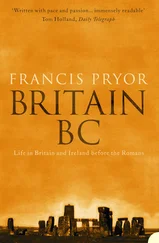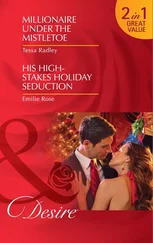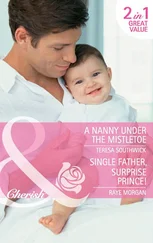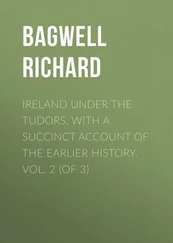Richard Bagwell - Ireland under the Tudors. Volume 3 (of 3)
Здесь есть возможность читать онлайн «Richard Bagwell - Ireland under the Tudors. Volume 3 (of 3)» — ознакомительный отрывок электронной книги совершенно бесплатно, а после прочтения отрывка купить полную версию. В некоторых случаях можно слушать аудио, скачать через торрент в формате fb2 и присутствует краткое содержание. Жанр: foreign_antique, foreign_prose, на английском языке. Описание произведения, (предисловие) а так же отзывы посетителей доступны на портале библиотеки ЛибКат.
- Название:Ireland under the Tudors. Volume 3 (of 3)
- Автор:
- Жанр:
- Год:неизвестен
- ISBN:нет данных
- Рейтинг книги:3 / 5. Голосов: 1
-
Избранное:Добавить в избранное
- Отзывы:
-
Ваша оценка:
- 60
- 1
- 2
- 3
- 4
- 5
Ireland under the Tudors. Volume 3 (of 3): краткое содержание, описание и аннотация
Предлагаем к чтению аннотацию, описание, краткое содержание или предисловие (зависит от того, что написал сам автор книги «Ireland under the Tudors. Volume 3 (of 3)»). Если вы не нашли необходимую информацию о книге — напишите в комментариях, мы постараемся отыскать её.
Ireland under the Tudors. Volume 3 (of 3) — читать онлайн ознакомительный отрывок
Ниже представлен текст книги, разбитый по страницам. Система сохранения места последней прочитанной страницы, позволяет с удобством читать онлайн бесплатно книгу «Ireland under the Tudors. Volume 3 (of 3)», без необходимости каждый раз заново искать на чём Вы остановились. Поставьте закладку, и сможете в любой момент перейти на страницу, на которой закончили чтение.
Интервал:
Закладка:
There can be no doubt that the court of Rome had urged upon that of Spain the necessity of relieving Desmond. But Philip II. was never in time, and his energies, such as they were, were absorbed by Portuguese affairs. It was not until the final defeat of Strozzi’s expedition to the Azores that Irish exiles could get their business attended to. The Cardinal of Como became friendly once more, and sent for William Nugent almost as often as the post arrived from Spain, saying that he remembered him at every turn of his beads. The Pope saw Nugent every six weeks, and the intervals were spent in making interest with Gregory’s son Giacomo, whose influence over the aged Pontiff had become very great. It was confidently reported that the whole Spanish fleet would sail for Ireland on its return from the Azores, but only two ships actually arrived. The papal bishop of Killaloe, Cornelius Ryan, had been sent by Desmond to Spain towards the end of 1582. In the spring of 1583 it was announced that help was coming, but it may have been delayed until the return of Santa Cruz and his fleet. Desmond had been dead nearly two months when the tardy succour arrived. Bishop Ryan appeared on the west coast with one large ship laden with artillery. Another, also with munitions of war, anchored in Ringabella Bay outside Cork harbour, and sent a boat, which brought off a countryman. Of those on board the chief spokesman was a friar named Shane O’Ferrall, who wept bitterly on hearing of Desmond’s death. A Spaniard wrote down all the particulars. ‘Is there none of the Earl’s name,’ he asked, ‘that will take upon him to follow and maintain that enterprise? You say none. Well, if any had continued it until now, we had brought here to furnish them treasure and munition good store, and shortly they should have had more, and aid enough.’ There were three bags of silver and two of gold, each as much as a man could carry. A present was sent by O’Ferrall to a lady living close by – marmalade, lemons and figs, a poignard, and a taffeta scarf – and then finding their occupation gone, the strangers left the coast. Don Antonio and Philip Strozzi had not saved Portugal, but they had destroyed Spanish influence in Ireland. 110 110 Ormonde to the Privy Council and to Burghley, Jan. 11, 1584, with enclosures; Wallop to Walsingham, Jan. 21.
Within a week of Desmond’s death the newly made Baron of Leitrim came to a violent end. Public opinion attributed the deed to his brother, and no doubt he profited largely by it. Clanricarde himself said that he had intercepted a band of traitors in the Baron’s company, and that he fell in the scuffle. His sister, Lady Mary, clamoured loudly for vengeance, but the Earl found means to silence her. A competent English observer tells us that ‘Sir John of the Shamrocks,’ as the Irish called him, was the best beloved man in Connaught, perhaps in all Ireland. ‘He was very well spoken, he was courteous, he was liberal to every man that had occasion to try him, in his house he was very bountiful, and he wrote better than any Irishman whose letters I have seen… First he would speak fair to every man, and mean no truth to any man that was honest. He had always a treasonable mind, and did ever thirst after blood. He was betrothed to one woman, and, leaving her, he was married to two others; they are all three alive. He was a common haunter of women, and men say he had a child by his own sister, and a great maintainer of thieves he was… The Earl will not steal from one to give to another. He will not spare the offender for any respects; I mean thieves: other offenders are seldom punished in Ireland, and never among the Irish.’ The Earl offered to prove the incest by irrefutable witnesses. The Lord Justice thought the simplest plan was to attribute the murder to the mutual hatred between the half-brothers since their cradles. They advised that Clanricarde’s future good conduct should be secured by a pardon, ‘especially in those remote parts where so many heinous facts contrary to the laws of God and man have been infinitely borne with in all ages.’ Three years before, when Clanricarde was ill, it was generally supposed that his brother had poisoned him. To avoid further confusion the English Government thought it better to allow a pardon. The murdered man had no legitimate children, and the peerage died with him. This long-standing faction fight was now at an end; the Earl was undisputed master over all the possessions of his house, and became the mainstay of English law and order in the West. 111 111 John Browne to Hatton and Walsingham, Nov. 19, 1583; Clanricarde to the Privy Council, Jan. 31, 1584; Lords Justices to the Privy Council, March 28, 1584; Wallop to Leicester, Jan. 26, 1581, in Wright’s Elizabeth . The Four Masters bear out Browne’s statement as to John Burke’s popularity; see also a damaged paper calendared under Nov. 1583 (No. 99). The Earl’s pardon passed the Irish Council, June 28, 1584. Lady Mary married O’Rourke. ‘That honest woman,’ Bingham wrote some years later, ‘is deceased in childbirth’ (to Gardiner, June 10, 1589).
The once mighty tribe of the Leinster O’Connors had fallen very low, but even the miserable remnant could not keep from internecine war. Teig MacGilpatrick, who led one party, was accused by Connor MacCormac of killing men who were under protection. Connor retorted that they had broken into rebellion since protection was granted. The Lords Justices persuaded Connor, and Sir Nicholas White persuaded Teig to appear and accuse each other. An appeal of treason was thus technically constituted, and for this they were told that trial by battle was the proper remedy. Fearing, it would appear, that the courage of the litigants might ooze away, the combat was fixed for the next day. The Lords Justices and Council sat solemnly in the inner Castle yard, the display being made more impressive by a large attendance of military officers. The proper ceremonies were observed, and the Lords Justices were careful to excuse any possible want of accuracy by pleading the shortness of the time. The combatants who were allowed only sword, target, and skull-cap, were stripped to their shirts and searched by Secretary Fenton himself. They then took their seats on two stools at opposite ends of the lists, and the pleadings having been read a trumpet sounded the onset. Connor, who was wounded twice in the leg and once in the eye, attempted to close, but his adversary was too strong for him. Having stunned and disarmed his accuser, Teig, who was himself seriously wounded, ‘but not mortally, the more was the pity,’ cut off his head with his own sword and presented it on the point to the Lords Justices, one of whom, be it remembered, was the Archbishop of Dublin. Fenton sent the sword to Leicester, ‘wishing her Majesty had the same end of all the O’Connors in Ireland.’ ‘We commend,’ they said, ‘the diligent travail of Sir Lucas Dillon and the Master of the Rolls, who equally and openly seemed to countenance the champions, but secretly with very good concurrence with us and between themselves for her Majesty’s service.’ 112 112 Lords Justices to the Privy Council, Sept. 12, 1583. Fenton to Leicester and Warwick, Sept. 13, in Carew ; Hooker. This is one of the last, if not the very last trial by combat in the British Islands. Lord Reay’s case, in 1631, is in Howell’s State Trials , vol. iii., with a minute account of the ridiculous ceremonies proper to such a mode of trial; but in that case the fight did not actually take place.
The Lords Justices hoped to make more O’Connors kill one another, but a second combat arranged to take place two or three days later was frustrated by the non-appearance of the accused, a brother of the victorious Teig, who had accepted the challenge for him. His adversary, Morrogh-ni-Cogge, came into the lists and made proclamation for two hours with drums and trumpets. Morrogh was adjudged victorious, but the absent man described him as ‘readiest to fight with those that he knew were farthest off from him.’ He urged that his brother had no right to promise for him, that Morrogh was too base a fellow to place in the balance with him, and that he could not be spared until his brother had recovered. ‘Notwithstanding,’ he added, ‘when my brother is whole of his wounds and able to take charge of his men, if it shall please the Lords Justices to call Morrogh and me face to face, that I may know upon what ground and quarrel I am to fight, I will then make it openly known how little able that vain boaster is to stand in my hands, who at the very sound of my name was wont to trot over whole countries.’ 113 113 Reasons of Brian MacGilpatrick O’Connor &c. (translated out of Irish), Oct. 15, 1583. The brothers seem to have subsided, or as some would say risen, into farmers.
Интервал:
Закладка:
Похожие книги на «Ireland under the Tudors. Volume 3 (of 3)»
Представляем Вашему вниманию похожие книги на «Ireland under the Tudors. Volume 3 (of 3)» списком для выбора. Мы отобрали схожую по названию и смыслу литературу в надежде предоставить читателям больше вариантов отыскать новые, интересные, ещё непрочитанные произведения.
Обсуждение, отзывы о книге «Ireland under the Tudors. Volume 3 (of 3)» и просто собственные мнения читателей. Оставьте ваши комментарии, напишите, что Вы думаете о произведении, его смысле или главных героях. Укажите что конкретно понравилось, а что нет, и почему Вы так считаете.












